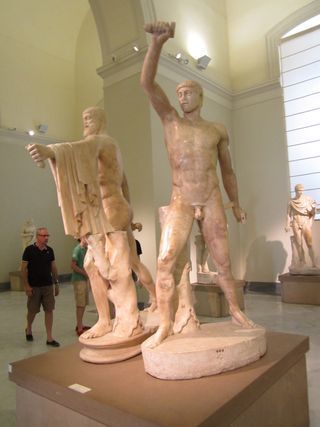A closer look at the tyrant slayers
As the husband rightly says, art history is pretty easy if you do it from books. It's when you take a closer look at the objects themselves that things get more difficult.
Well so it appeared today in the Naples Archaeological Museum, taking a closer look at the so-called "Tyrant Slayers" (or, rather Roman version thereof).
The standard story of these is complex in its own way, but has a relatively simple ending. The subjects in question are the Athenian heroes, a pair of lovers called Harmodius and Aristogeiton; these became canonised heroes of the fledgling Athenian democracy in 514 BC, when they killed Hipparchos -- the brother of the ruling tyrant -- who had (among other his other crimes) made up to Harmodius.
It was in fact a bit of a bosh shot. The pair managed to kill Hipparchos, but not the ruling tyrant Hippias, and they both ended up dead. But it was the first step in the deposing of the autocratic regime; and when Hippias had actually been got rid of, the new democracy put up a statue to honour the "tyrant slayers", by the sculptor Antenor.
This didn't last long. When the Persians sacked Athens in 480 BC, they took this symbol off with them, and it ended up in Susa. Although Antenor's version was later returned to Athens, the substitute statue that the Athenians commissoned (by Kritios and Nesiotes) quickly became the iconic image.
Neither the original or substitute actually survive, but what we are always told is that the Roman version in Naples (from the Farnese collection) of Kritios and Nesiotes' "Tyrannicides" is a fairly good approximation (unless you think that the Naples version actually copies Antenor's statues, which a few people do). And that's what you see above (Aristogeiton on the left).
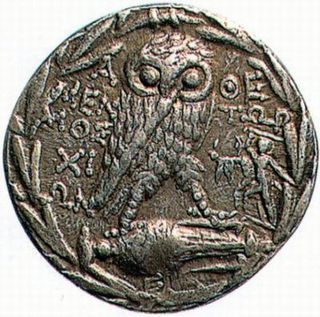 It all looks a pretty tight fit, especially if you take into account some classical Greek coins which show a pair of figures rather like that (on the left.. the little figures to the right of the owl), a few Greek pots showing the assassination in much this pose and a plaster cast of the face of the bearded Aristogeiton found at Baiae.
It all looks a pretty tight fit, especially if you take into account some classical Greek coins which show a pair of figures rather like that (on the left.. the little figures to the right of the owl), a few Greek pots showing the assassination in much this pose and a plaster cast of the face of the bearded Aristogeiton found at Baiae.
Looking at them yesterday, it all seemed a bit looser.
For a start, noone knows where these statues came from. There are unconfirmed and unreliable reports that they came from Hadrian's Villa at Tivoli (but there are unconfirmed and unreliable reports that all kinds of things came from there). All we really know is that the "Tyrannicides" were in the collection of Margaret of Austria (where they were drawn several times in the course of 16th century) and they went into the Farnese collection in 1586.
More interesting, and no less unpredictable, the pair have been hugely restored from the sixteenth century onwards, probably more than once. Not just the limbs. Aristogeiton (the older bearded one) was 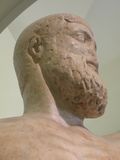 actually found headless, and currently sports a cast of a "head of Aristogeiton" from the Vatican (and you may see, on the right, it doesn't quite fit, despite the fact that this is the "canonical image"). In the late nineteenth century this "Aristogeiton" wore a quite different, beardless head (I'm not sure what happened to that). Harmodius seems to have been found with his head, but otherwise was pretty much a limbless torso, now restored as we see him.
actually found headless, and currently sports a cast of a "head of Aristogeiton" from the Vatican (and you may see, on the right, it doesn't quite fit, despite the fact that this is the "canonical image"). In the late nineteenth century this "Aristogeiton" wore a quite different, beardless head (I'm not sure what happened to that). Harmodius seems to have been found with his head, but otherwise was pretty much a limbless torso, now restored as we see him.
And for a long time the pair of them were identified as gladiators anyway.
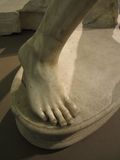 But even more curious were the bases, which certainly don't match. Aristogeiton's (left) looks like a bog-standard free standing Roman imperial base. Harmodius' base (below right) looks for all the world like a base that was inserted into something else, and it certainly isn't a pair for Aristogeiton's.The big Farnese catalogue says the Harmodius base is a restoration, and so it may well be (especially if the legs are restorations anyway).
But even more curious were the bases, which certainly don't match. Aristogeiton's (left) looks like a bog-standard free standing Roman imperial base. Harmodius' base (below right) looks for all the world like a base that was inserted into something else, and it certainly isn't a pair for Aristogeiton's.The big Farnese catalogue says the Harmodius base is a restoration, and so it may well be (especially if the legs are restorations anyway). 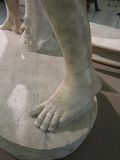 But it isn't all of a piece. The back half (under the back foot) is clearly different from the rest of it...So the restoration has gone in two phases.
But it isn't all of a piece. The back half (under the back foot) is clearly different from the rest of it...So the restoration has gone in two phases.
One thing is for sure: they have not always been seen as (or restored) as a pair.. though at some point Harmodius' tree-trunk support (which is definitely post-antique because it supports his already damaged bum, as you see below left) has been made to match Aristogeiton's "original" support.
All in all, it is hard to undermine the coin evidence for the "Tyrannicides" group, but the Naples "pair" (and it's the only surviving copy of the two of them) looked a hell of a lot more fragile after 30 minutes looking.
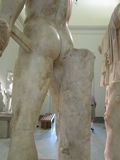 (I should confess that now I have done a bit of work on these -- such as you can from a Neapolitan hotel -- I suspect that some serious reading might have brought up these difficulties. But autopsy brought them up a hell of a lot quicker!)
(I should confess that now I have done a bit of work on these -- such as you can from a Neapolitan hotel -- I suspect that some serious reading might have brought up these difficulties. But autopsy brought them up a hell of a lot quicker!)
Mary Beard's Blog
- Mary Beard's profile
- 4114 followers


